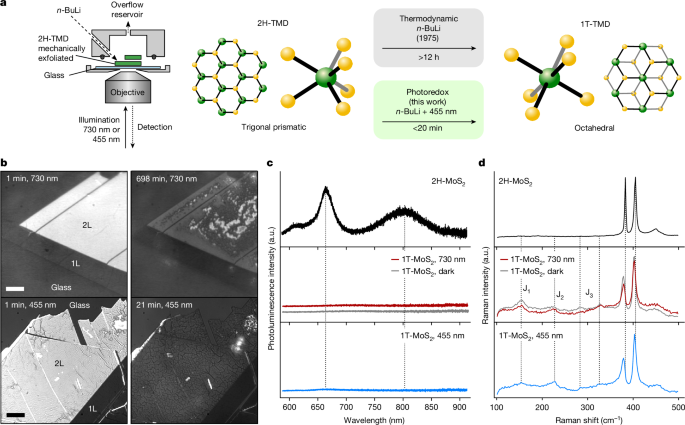Accelerating Phase Transition in 2D Transition Metal Dichalcogenides through Photoredox Engineering
The content discusses the use of photoredox engineering to accelerate the phase transition in two-dimensional transition metal dichalcogenides (2D TMDs) from the semiconducting 2H (trigonal) phase to the metallic 1T (octahedral) phase. This phase transition is typically achieved through chemical lithiation using the organometallic agent n-butyllithium (n-BuLi), but the underlying mechanisms are poorly understood, and the use of n-BuLi raises safety concerns.
The authors demonstrate that illumination at 455 nm can accelerate this phase transition by up to six orders of magnitude. They identify that the above-gap illumination improves the rate-limiting charge-transfer kinetics through a photoredox process. This method allows for rapid and high-quality phase engineering of TMDs, enabling the inscription of arbitrary phase patterns with diffraction-limited edge resolution into few-layer TMDs.
Furthermore, the authors replace the pyrophoric n-BuLi with safer polycyclic aromatic organolithiation agents, which exhibit superior performance as phase transition agents compared to n-BuLi. This work opens up opportunities for in situ characterization of electrochemical processes and paves the way for sustainable scaling up of materials and devices through photoredox phase engineering.
Настроить сводку
Переписать с помощью ИИ
Создать цитаты
Перевести источник
На другой язык
Создать интеллект-карту
из исходного контента
Перейти к источнику
www.nature.com
Photoredox phase engineering of transition metal dichalcogenides - Nature
Ключевые выводы из
by Juhwan Lim,J... в www.nature.com 08-28-2024
https://www.nature.com/articles/s41586-024-07872-5
Дополнительные вопросы
